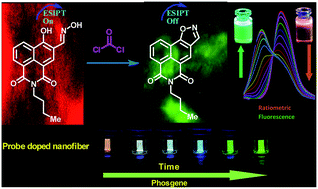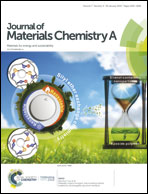Ratiometric chemodosimeter: an organic-nanofiber platform for sensing lethal phosgene gas†
Abstract
Herein, we report the fabrication of organic nanofibrils, using electrospun 3-oxime-4-hydroxy-1,8-naphthalic-n-butylimide (R1)-doped polycaprolactone (PCL), for application as a gaseous phosgene-specific sensing device. The phosgene-mediated adsorption of the nanofibers gives rise to an observable colorimetric switch from brown-red to pale greenish-yellow and a synchronized ratiometric spectral emission with significantly high Stokes shift. The high surface to volume ratio and innovative properties of the nanofiber mats lead to the diminution of response time in comparison to the composite film of the same materials. Proficient gas penetration allows a fast chemical reaction, which is proportional to the phosgene concentration and delivers a very low detection limit of 0.087 ppm. To the best of our knowledge, this is the lowest limit of detection of gaseous phosgene for any robust protocol to date. Confocal fluorescence imaging and scanning electron microscopy (SEM) studies revealed partial deformation on the surface of the nanomaterials upon the adsorption of phosgene, indicating the phosgene-mediated chemical transformation. The fluorescent naphthalic-oxime with an elevated specific surface area of nanofibrous polymeric supports proffers fast optical and visual phosgene detection for industrial and environment application. Importantly, the LOD of gaseous phosgene in all solid protocols used is far lower than the safe phosgene concentration levels for human exposure.



 Please wait while we load your content...
Please wait while we load your content...